| |
|
The Zoë Lund Cinematheque
Short essays on six films on which Zoë Lund
variously worked as actor, writer or director.
Ms .45 (1981): Retribution and Liberation
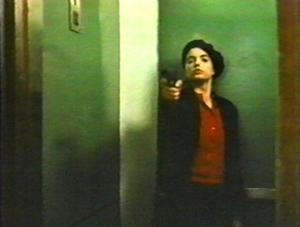 |
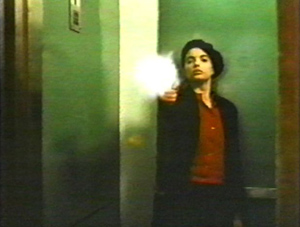 |
Under the name of Ringo Ray, Ron Pettersson has written on cult cinema.
Zoë Tamerlis was only 17 years old when she played the unforgettable role of Thana, the mute garment worker who turns from victim to vigilante on the streets of New York City, in Ms .45 (1981). Her remarkable performance relies on facial gestures and body language to convey Thana's range of emotions: loneliness, fear, pain, torment, rage, betrayal and finally despair. Abel Ferrara was clearly influenced by Roman Polanski's Repulsion (1965), in which the young Catherine Deneuve, who barely speaks, suffers from a pathological fear of rape, and mentally deteriorates in a house. Some critics have described Ms .45 as Repulsion meets Death Wish (Michael Winner, 1974). Many low budget exploitation films.in the '70s, including Rape Squad (1974) and I Spit on Your Grave (1978), covered the subject of rape, with the protagonists getting revenge against their attackers.
At the beginning of Ms .45, Thana appears shy and withdrawn. Her appearance in black coat, loose ankle length skirt and loose white office shirt suggests a virginal high school girl. The two horrific rapes Thana endures on her way home from work in a garment factory evoke the different storytelling ethics of American and European cinema. In American cinema the rape victim always seems to get revenge on her assailant. In European films rape occurs but is rarely avenged, as in Alan Clarke's Scum (1979) or Baise moi (2000). Ferrara's use of trashcans and a mask over the rapist's face suggest the animalistic nature of the first attack. The phallic guns in the films are variously a sign of weakness or strength; when Thana finally fires the pistol successfully, it is a symbol of her strength.
Nicholas St. John's script explores how the rape, abuse and exploitation of women occurs at all levels of society, as Thana turns from victim to avenging angel. Although Thana is at first a reluctant vigilante, Tamerlis' performance convincingly presents the post-traumatic horror and stress of rape. Ferrara plays on audience expectation by not showing Tamerlis naked when she attempts to strip (in true exploitation film fashion) - the scene becomes a nightmare, conveying the fear and vulnerability that the victim feels. This bathroom scene is both shocking and painful at the same time.
The next day Thana's appearance dramatically changes. She is wearing a beret (a strong militant motif) and stronger, more tightly fitting, 'young corporate professional' attire. Thana's facial expressions change from shy, timid looks, through horror and pain, to cold, focused stares of anger and silent outrage. There is a sense of her being more alert to the world through new eyes. In an interview with Danny Peary for Cult Movies 2 (Dell, 1981), Tamerlis commented on the comparative figure of Laurie (Darlene Stuto), Thana's loud, defensive co-worker: "At first Thana has admiration for Laurie, but later she feels contempt. Laurie talks a lot, but she's hypocritical. Thana can't talk, she can't bullshit. Her only way to respond is through action, which is more honest." When Thana guns down the annoying photographer, her first controlled and calculated killing, she is finally taking action against the men who make her life miserable. Where Laurie moans about men, Thana takes control of the situation and grows stronger through taking direct action.
In another identity transformation Thana stares wide eyed into a mirror, heavily putting on heavy lipstick. She is dressed sharp, more elaborately made-up, with a slicked back, tight pony tail. In Central Park after dark, she walks into gang territory like a lone western gunslinger, the gang circling her with weapons. Thana empowers herself by controlling and dominating leering men. Later, she raises herself above her colleagues who are mere voyeurs. Tamerlis shows remarkable range during these scenes, from street soldier to flirtatious office girl. Her subsequent ventures into the streets become more complex. She encounters an extreme polarity of men, one who presents no problem and another who is self-destructive.
At the office party, Thana is dressed as a nun, but wearing heavy make up and lipstick - Madonna/Whore duality. She dances with her boss who is dressed like Count Dracula, the vampire who craves the blood of female virgins in order to feed off and sexually enslave them. In nightmarish slow motion, Thana shoots the men at the office party one by one; the final man killed is in drag, wearing a bribe groom dress - symbol of women's societal and religious submission to men in marriage. Laurie betrays Thana by stabbing her in the back; interestingly, she grips a large, phallic knife between her legs, suggesting an erection. The smeared lipstick around Thana's mouth as she screams suggests a vampire, struck in the back after having consumed blood. Tamerlis notes how intimate Thana's reality was to her: "I like Thana a lot, I knew a lot about her that others didn't ... Her dream was to become a model, but she had no hope of leaving the sweatshop. She was very innocent. She'd seen a lot but hadn't done anything. She had a conscience, but not a whit of consciousness until she was raped ... The real villain is Thana's boss, who wants to keep his women for forty years in his service."
The act of betrayal by Laurie, who is merely verbal in her response to obnoxious men, signifies how she ultimately protects the men who keep her enslaved in the sweatshops. Thana steps over the line, while Laurie never does, remaining within institutional confines. Thana's violent last stand is against an industry that enslaves women not only to the sweatshops, but also the constant, everyday notions of beauty, sexuality, and fashion. Thana's dream (as interpreted by Lund) to be a catwalk model forever eludes her – it is an expression of the same innocence that led her to slavery at the hands of a male-dominated industry built on stifling regimes of vampirish exploitation. The American way of settling disputes with a gun can easily find its tables turned when a woman is cornered. Thana, on her own, desperately wants something, anything, that will rectify the social problems that have kept her down for too long. Her journey into violent retribution is a personal liberation.
© Ron Pettersson August 2002
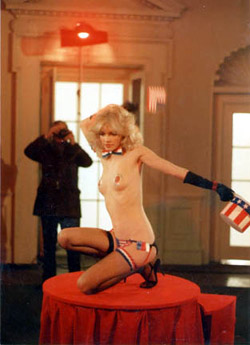 |
Special Effects (1984): Madcap
By Adrian Martin
Adrian Martin was the Special Dossiers Editor of Senses of Cinema until his resignation from the magazine in August. The tribute to Zoë Lund is his last Special Dossier, and this piece – revised from a review which first appeared in Freeze Frame vol. 1 no. 4 (July 1987) – is his final contribution to Senses of Cinema.
Independent writer-producer-director Larry Cohen is a strange and fascinating case in contemporary cinema. Rising from obscurity in early 1970s 'blaxploitation' to cult fame for films including It Lives Again (1978), The Private Files Of J. Edgar Hoover (1977) and Q – The Winged Serpent (1982), Cohen still sits uneasily in anyone's critical canon. For there's a way of abstracting every Cohen film – in one's memory, or in the train of a critical discourse – that can make it sound incredibly sophisticated and complex, perfectly realized and ideologically well-intentioned. Actually watching and hearing a Cohen film can be quite another matter: they're often slap-dash, slipshod and insanely off-the-wall. This makes him a spiritual cousin (as well as real-life friend) of Samuel Fuller, in whose films we also find endlessly brilliant ideas thrown onto the screen in a gloriously hit-and-miss fashion. By the mid '80s, Cohen's career approached the stage Fuller's was at around Dead Pigeon On Beethoven Street (1970): aware of his cult status, Cohen started succumbing (in his more personal low budget 'quickies') to all manner of in-jokes and games. (1)
Enter Special Effects, made back-to-back with Blind Alley (1984), and a very queer number indeed. I couldn't honestly say there is a single fleshed-out element in Special Effects – dramatically, psychologically, emotionally or thematically. And there certainly isn't anything going on worth blessing with the title of mise en scène. Every sequence is like a rough sketch for a film Cohen would do properly if he had the time and the money. But what great ideas the man has! The main cluster of concepts in Special Effects concerns the psychodramatic interrelation of 'real life' - country boy Keefe (Brad Rijn) losing his wife Andrea (Zoë Tamerlis) to New York's filmdom allure – with a cinematic fiction. The latter is embodied and generated by the malevolent Chris Neville (Eric Bogosian). There's a wackily indecipherable Chinese-box game set in motion between Neville's film, Cohen's representation of it, and yet another version of the events purportedly constructed after the fact by the hilarious starstruck cop Phillip Delroy (Kevin O'Connor). These switches of level don't bear any retrospective logical scrutiny (the Delroy thread was added late in the shooting, and it shows), but their arrangement is dizzying and suggestive enough to create a momentum.
So far, it's pretty clear-cut as a schema: the power relations of the filmmaking situation resonate as a metaphor for problems of sexual identity, à la Vertigo (1958). Hitchcock's classic is only one of the films plundered at length here, but it was certainly uppermost in Zoë Lund's mind. She commented in a 1996 interview, "It amused me to play two roles, a little like Vertigo" – although her voice (to her chagrin) was dubbed for one of these roles. (2) Sophie Charlin writes admiringly of this double casting and its place within the Zoë Lund Cinematheque: "Zoë has several faces and several bodies; her portrait is a confluence of figures, a diffraction of images." (3)
However, Cohen being the shameless and slightly crazed opportunist that he is, a thousand and one other notions get thrown into the brew. Only he would seize on the effervescent cinematic potential of anything from Lund's ability to wiggle her ears to a chance to pastiche an hour of Paris, Texas in two minutes flat. Cohen is also fond of a brand of madcap, scattershot, screwball humour (see his Full Moon High [1981]) which fills Special Effects with delicious 'behind the scenes' detail, but simultaneously tends to drain it of any enduring, coherent significance.
Special Effects is, ultimately, a film for Cohen aficionados. They can graciously overlook the holes that riddle it, in order to revel in the fleeting brilliance of ideas and allusions. Anyone who stumbles upon it unacquainted with the director's colourful career may simply find it mad – and they would have a point. Somewhere between the starry-eyed idealization of Cohen as a rigorous, intuitively intellectual auteur and the pop-eyed disbelief that greets his wilder excesses, we can locate a filmmaker whose real genius is located precisely in his monster-embracing madness, not above or despite it. In that imaginary canon – which will never, ever be mistaken for the Sight and Sound ten-yearly poll - Special Effects holds a true and rightful place.
© Adrian Martin 1987/2002
Endnotes:
- See my entry on Fuller in the Great Directors database, July 2002.

- Nicole Brenez and Agathe Dreyfus, "Enteretien avec Zoë Lund", Admiranda/Restricted no. 11/12 (1996), p. 246. An English translation can be found at http://www.zoelund.com/docs/CF-interviews/Interview1-0796.html

- Sophie Charlin, "Zoë Lund, hommage à une héroïne", Balthazar no. 5 (Spring 2002), p. 49.

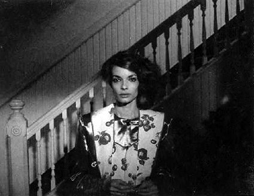 |
The Houseguest (1987):
Black and White Mischief
By Sophie Charlin
Sophie Charlin is a critic and co-editor of Balthazar.
Three years after Special Effects, where she incarnated a blonde pinup of the '80s with a Hitchcockian destiny, Zoë Lund took the principal role in a strange and rare thirty minute, black and white film directed by Austrian-born director Franz Harland. Credited this time under the name of Zoë Tamerlaine, she plays Marla, the bewitching, tempting host to a 'professional houseguest' (Bolek Gryczinski, a painter who died of AIDS), and bride of a rather confused fisherman (a rare film appearance by John Cale, who also composed the score). In a mysterious and comic atmosphere conjured from spiritualism, dreams and incongruous jokes, the husband faints and the woman seduces the unknown Pole, who ends up magically disappearing under Marla's mischievous gaze.
It is surprising to see Zoë Lund, in black and white, in a house in the middle of the countryside or at the edge of a deserted beach. Of course, this New York actress does not fit with such a desolate decor, nor with her lover with his braces and moustache. It is precisely these bizarre displacements which make The Houseguest such an intriguing entry in Lund's filmography.
A star and fashion model, more than ever Lund's performance is based on wide-eyed, mocking winks to the audience, which go beyond the 'vamping' of her two partners, via costumes and hairstyles that are as elegant as they are strange. She borrows the classical distinction of a '50s Hollywood star, in order to point her nose just a little further, black curls swept to the side, sporting an incredible hairstyle that is pure '80s, worn in a bun, with a large, veiled hat or a motorcycle helmet.
One senses Lund's enjoyment in disguising herself with hats and old clothes as she plays a grand priestess and even ... mimes a whale. In this near surrealist film, Franz Harland knows how to reveal the entirety of Zoë Lund's malice – and who could have guessed it would be so terribly funny?
Translation: Adrian Martin
© Sophie Charlin August 2002
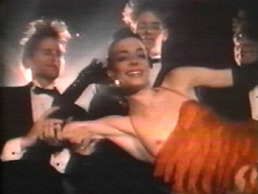 |
Exquisite Corpses (1988):
Revolt into Charisma
By Brad Stevens
Brad Stevens is the author of forthcoming books on Abel Ferrara and Monte Hellman.
During the opening credits of Temistocles Lopez's Exquisite Corpses, we hear the song "Me and My Trombone", written and performed by Gary Knox. During the end credits, we hear the song "I'll Have My Cake and Eat It Too", written and performed by Zoë Lund. The film's progress is evident from the extreme difference between these numbers created by its male and female stars: the first tells of how the protagonist, Tim Lee (Knox), plans to take New York by storm with his trombone; the second describes an impossibility, and essentially states the philosophy not only of Belinda Maloney, the character, but also of Lund herself.
Exquisite Corpses provides an excellent example of how narrative can be deformed and derailed by a charismatic female star. At first, there seems little doubt that what we are watching is a variation on Midnight Cowboy (John Schlesinger, 1969), a work with little time for its female characters: the tale of a dumb Texan trying to find success in New York. For some forty minutes, the film appears to be essentially a realist text: we see Tim being ripped off by various hustlers, evicted from his hotel, making friends with a bag lady, etc, all filmed on authentic New York locations. Then, at close to the halfway point, Tim is taken under the wings of a gay Svengali, and becomes an overnight sensation performing a Brechtian cabaret act. It is at this point that Lund, who had already made a brief appearance pretending to be a prostitute, reappears as Belinda, and the film spirals off into a virtually incomprehensible story involving Communist spies, the CIA, a conspiracy to murder Belinda's husband, and several other totally indigestible elements.
It would, of course, be ridiculous to claim that Lund was in any way responsible for these developments (she had no hand in the screenplay, which was written by Lopez – whom Lund referred to as "an impossible director"), but her unique presence is certainly what allows the film to succeed. As Lopez must have been aware, such a fundamental shift in the text's nature required a strong central anchor, something provided by Lund's Belinda, who (like Ms .45's Thana) adopts the trappings of femininity in order to achieve ambitions which are totally hostile to patriarchy. Tim starts out as a macho male trapped within his cowboy persona, but soon becomes a bisexual star performing a dance routine in drag, and it is Lund who negotiates this transition: if Tim was initially unable to accept that masculinity and femininity need not be rigidly defined concepts ("Some people don't even know what sex they are," he complains), it is Lund, with her bright red lipstick and curious manner of speaking, who demonstrates how gender roles can be parodied to specifically political ends (her 'feminine' persona is as much a drag act as Tim's routine in stockings and a dress), just as Lopez demonstrates how narrative 'norms' can be subverted through a process of deconstruction. The otherwise bizarre introduction of the Communist spies thus makes perfect sense, the undermining of cinematic and sexual conventions being imbricated with an attack on America's right-wing political mainstream. In this film from a gay writer/director and a gay male star, the norms of gender, narrative and politics exist only in quotation marks.
© Brad Stevens August 2002
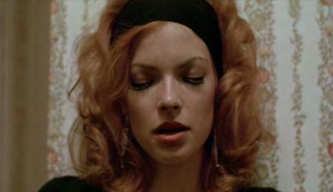 |
Bad Lieutenant (1992):
Everyday Christ
By Ron Pettersson
Under the name of Ringo Ray, Ron Pettersson has written on cult cinema.
Zoë Lund collaborated with Abel Ferrara on creating one of cinemas most unforgettable cops, a nameless New York Detective named in the credits only as LT (Harvey Keitel). LT does not have a strong, opposing, moral cop to stop his unlawful activities or fight the corrupt system, as in Mike Figgis' Internal Affairs (1990). LT's story is not so black and white. Although his worst enemy is himself, his behaviour is a means to spiritual fulfilment amidst a backdrop of moral deterioration in the New York city streets. In a 1992 Time Out interview, Ferrara cited two sources for the story: an incident in 1982 where a nun was raped in Spanish Harlem, and a rap lyric he wrote called "Bad Lieutenant", about a crooked cop who steals drugs, sleeps with prostitutes and cheats on everybody around him. Ferrara originally offered the writing assignment to his long time collaborator Nicholas St John, but he turned it down. Ferrara then offered the job to Zoë Lund, who completed a draft in two weeks.
Bad Lieutenant takes on complex notions of religious faith, and the search of redemption in a debased society. Some critics called it the ultimate Catholic guilt trip film, while others interpreted it as a modern day Christ story, which was closer to Lund's intention. In Nick Johnstone's interview with Lund in Abel Ferrara: The King of New York (Omnibus Press, 1999) she comments: "If someone has a more human sense of justice and the priorities of justice, I think that person could be judged as corrupt. Corruption does not make the Lieutenant a sinner. I always like to point out that Christ himself hung out with whores and tax collectors." LT spares everyday criminals in order to seek and maintain a drug induced enlightenment.
The narrative pace of LT's wanderings during the first day and night is tight and engaging. He is an observer. The next day, after hearing of the sadistic rape and torture of a Nun (Frankie Thorn) in Spanish Harlem, LT is indifferent to the collective outrage of his fellow cops. The point LT makes (and it has been echoed by Ferrara in interviews) is that the Church makes the Nun's rape an outrage, while the women on the street who are rape victims suffer alone and in silence – as Ms. 45 shows so well. After his disquieting face-to-face encounter with the nun, the tenor of LT's daily activities changes. On the streets driving and drinking vodka (an interesting choice of alcohol: clear spirits), LT precipitates the queerly celibate (i.e. masturbatory) encounter with two young women that he stops and harasses. The 'real time' nature of this scene emphasises LT's frightening masochistic nature of self-punishment and his confused sexual angst, magnified after having being affected by the Nun's rape. Although LT is a father of two children, it seems that family life is a past he can leave behind him (when the mob man nicknamed Judas comments that the Mafia bookies will blow up his house with his wife, kids and family inside, LT doesn't care – as a Catholic, he's blessed and imperishable).
In the church which is the scene of the crime, LT cradles next to the fallen statue in a foetal position. The next day, his puts his faith to test as a Christ figure on the streets. The words he hears the Nun speak about the needy – "Those boys, those raging sad boys, they came to me as the needy do, and like many of the needy they were rude, and like all the needy they took. Like all the needy they needed" – communicate the shared compassion felt by both for desperate, spiritually deprived souls. LT learns of the Nun's intention of bearing the child from the rape – "turning hate into love like Christ did" – but he has yet to cross over to the sacred side as she has done. LT snorts coke on his daughters communion photos - a symbolic rejection of officialised church values – and then silently looks over his sleeping children like a stranger in the house.
On the night streets LT descends further – through corridors and down stairs from nightclubs to a coke dealer's apartment. LT can't turn back now, and he begins to close in on his fate as a Christ figure. When he visits Zoë again to mainline heroin, she makes a profound statement about addiction: "Vampires are lucky, they can feed on others. We gotta eat away at ourselves. We gotta eat our legs till we have the energy to walk. We gotta come so we can go. We gotta suck ourselves off. We gotta eat away at ourselves till there's nothing left but appetite." LT falls into a dream replete with Catholic imagery – preparing for the later scene in which he will have a vision of Christ that changes the direction of the narrative - the clue that has eluded LT arrives via a religious vision.
After tracking down the two boys responsible for the rape, LT vents his moral outrage in a kind of self-exorcism. Finally, at the bus terminal LT puts himself to the test, giving the boys the drug money that is inside a Catholic communion box, and freeing them in an act of forgiveness. Alone, LT howls in despair, a moment of spiritual transformation. Outside the bus terminal he is then crucified with bullets by the angry mobsters. His fate and mission in life as a holy figure wandering the city streets is thereby sealed. Like Christ, LT is a figure with no past and his life ends suddenly, in his completion of holy servitude amidst the everyday banality of the streets of New York.
© Ron Pettersson August 2002
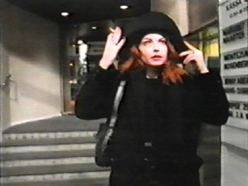 |
Hot Ticket (1993): Freedom High
By Nicole Brenez
Nicole Brenez, teacher and programmer, is currently writing a book on Abel Ferrara. This is her final contribution to Senses of Cinema.
In 1993, Zoë Lund found herself at the Rotterdam Film Festival. To thank the organisers for their kindness and hospitality, she jumped at the offer to make a film, Hot Ticket, which she wrote, performed and directed in three days. Her work was included in a collective feature, Scenes from Rotterdam (signed by Mijke de Jong). (1) Hot Ticket lasts barely over a minute and a half. Like all good films (by Edison, the Lumière brothers, the young Lumières, Peter Kubelka) which use such a short form in order to achieve intensity, it constitutes an advanced point of ingenuity.
Hot Ticket unfolds in two shots. The first is brief: Zoë, dressed entirely in black, a large black hat in her hand, finds herself in the foyer of a cinema decorated in red velvet. She moves towards the camera, as if leaving a screening. Then a sequence-shot: Zoë, now wearing her immense hat, descends a staircase and heads towards the cinema's ticket box. Instead of money she slides a full syringe under the glass. The cashier gives Zoë a ticket which she pockets. Then, a little edgily, she asks: "Am I too late?" "No," answers the cashier. "No, you just made it. You can go in now." At once relieved and resigned, Zoë sets forth, moves towards the camera, leaves the cinema, and ends up in the street. It is dark. The camera pulls back to show her in wide shot, utterly vulnerable out in the world. Then it pans away from her to show the façade of the cinema (the Luxor), while her voice-off utters: "That which is not yet, but ought to be, is more real than that which merely is". The camera pans back to her. Distraught, she glances right and left, and then looks directly into the camera. Adjusting her enormous hat, she turns around, moves slowly away to the right, thrusting herself along the paved street that is illuminated by commercial signs, until she disappears among the passers-by.
Hot Ticket constitutes a visual apologue. Like everything Zoë created (for instance her performance in Ms .45, the script of Bad Lieutenant, and her unpublished novel trilogy 490), it returns us to the most naked and vivid state of existential necessity. At the start of the twentieth century, the first theorists of film, fascinated by the analogical properties of this new medium, imagined how the cinema might reach its fulfilment. The public would enter the theatre, at the front of which would be set not a screen against a wall but, in place of that wall, a transparent window through which each spectator could directly watch the street and its spectacle of real life. It would take a century for someone to think of traversing that great, theoretical film theatre, passing through the glass and describing candidly what is to be found in that street: a pure experience of anguish, solitude and destitution which demands, moment by moment, an experimental bravura.
But what is this hot ticket that guarantees the inversion of entry and exit, theatre and world, birth (the red, uterine ambiance of the Luxor) and death (the anguished eviction into the night), cinema and reality? Or, in eminently concrete terms, what makes us live, what is that that flows in our veins and allows us to stand tall? What do we believe in, what are we addicted to? To the heroine, to love, courage? To creation? To ourselves? Hot Ticket answers radically. The inversion between theatre and world is not just a neat twist. It signifies a revolution. The proposition spoken off-screen by Lund offers the essential formula of ethical exigency; it necessarily founds all culture of protest, the revolutionary imperative, and the vigilant safeguard of hope.
We must recall here the militant environment in which Zoë Tamerlis-Lund swam: an activist from her adolescence, just after the filming of Ms .45 she met Edouard (Yves) de Laurot, one of the noblest (and least known) figures in cinema history – a hero of the Polish and the British Resistance movements, friend of James Baldwin, director of (among others) a film with Malcolm X, Black Liberation (1964) – a masterpiece of cinema engagé. With him and all the others to whom he introduced her, Zoë penetrated to the very source of the revolutionary movement of the '50s, the Black American organizations that served as models for every subsequent armed struggle, beginning with the SNCC (Student Nonviolent Coordinating Committee) which launched the Freedom Summer of 1964 with its slogan: 'Freedom High'.
Hot ticket, high freedom, high fidelity to what ought to be and will be. From the Black Civil Rights Movement to the aesthetic of struggle advocated by Abbie Hoffman, the activist works in the name of a world that will one day be more just. In 490, Zoë offers a portrait of herself as a black militant ("She is black. She is a junkie. She is incredibly sexy and doesn't apologise"), capable of sacrificing her life to her ideals in a gesture that is not romantic or exalted but logical and efficacious. What we are addicted to, what replaces the syringe, is a belief in the possible fullness of life, in the absolute intoxication of the true, or rather the real (for Hegel, "The truth is thus the bacchanalian revel, where not a member is sober.") (2) Hot Ticket offers, in this sense, the best possible introduction to the work of Abel Ferrara, since it echoes the same principle, an attentive conservation of fundamental ethical values – values which Ferrara places under the aegis of Patrick Henry (Mayor of Virginia during the American Revolution) and his celebrated declaration of 1775: "Give me liberty or give me death."
Life truly lived is a dangerous, violent and bewildering experience; for in the real world – meaning the inverted world of injustice and mutilated existence - it can scarcely be lived other than as a Passion. The separate and collaborative works of Lund and Ferrara arise from the same, tragic conception (i.e., fiercely attached to the realisation of the true in spite of all concrete historical evidence), a conception of life as political Passion. This idea was admirably illuminated by Antonio Gramsci in his Prison Notebooks of 1931-2:
Translation: Adrian Martin. Nicole Brenez thanks Stéphane Delorme, Agathe Dreyfus, Robert Lund and Brad Stevens. The original French version of this text can be found at http://zoelund.com/filmvid/hotticket/brenez.html.
© Nicole Brenez August 2002
Endnotes:
- According to a 2002 interview with de Jong, the only print of the film was lost in transit shortly after its completion. However, a videotape copy has recently surfaced; Zoë Lund's segment was screened in Paris at the Grand Action cinema as part of the 'Festival Balthazar' on 15 March, 2002.

- G.W.F. Hegel, The Phenomenology of Mind, trans. J. B. Baillie (London: Allen & Unwin, 1971), p. 105.

- Antonio Gramsci, "Politics as an Autonomous Science", from Quintin Hoare & Geoffrey Nowell-Smith (eds. and trans.), Selections from the Prison Notebooks (New York: International Publishers, 1971). Internet version: http://www.marxists.org/archive/gramsci/editions/spn/modern_prince/ch03.htm

© Senses of Cinema 1999-2004